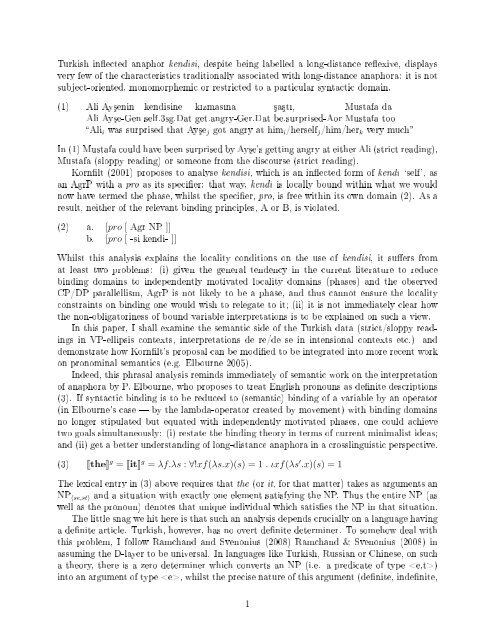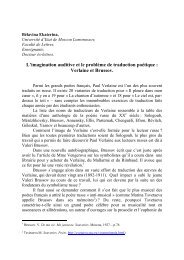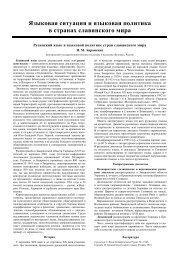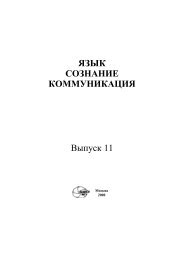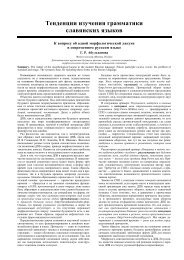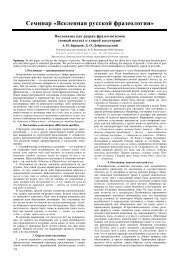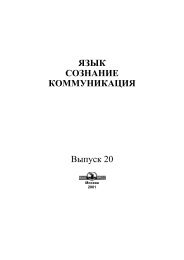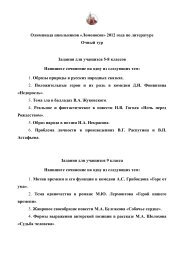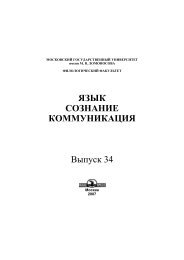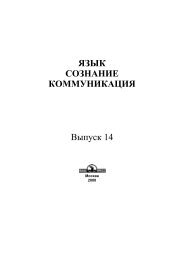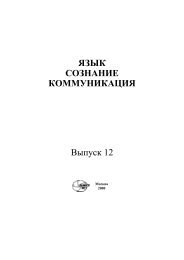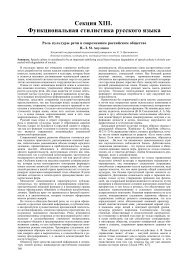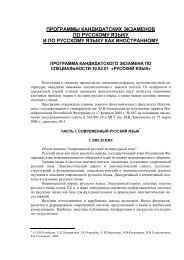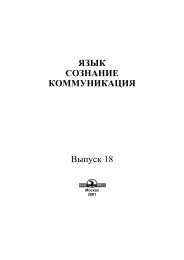Semantics and Syntax of Turkish kendisi
Semantics and Syntax of Turkish kendisi
Semantics and Syntax of Turkish kendisi
Create successful ePaper yourself
Turn your PDF publications into a flip-book with our unique Google optimized e-Paper software.
<strong>Turkish</strong> inected anaphor <strong>kendisi</strong>, despite being labelled a long-distance reexive, displaysvery few <strong>of</strong> the characteristics traditionally associated with long-distance anaphora: it is notsubject-oriented, monomorphemic or restricted to a particular syntactic domain.(1) Ali Ay³enin <strong>kendisi</strong>ne kzmasna ³a³t,Mustafa daAli Ay³e-Gen self.3sg.Dat get.angry-Ger.Dat be.surprised-Aor Mustafa tooAli i was surprised that Ay³e j got angry at him i /herself j /him/her k very muchIn (1) Mustafa could have been surprised by Ay³e's getting angry at either Ali (strict reading),Mustafa (sloppy reading) or someone from the discourse (strict reading).Kornlt (2001) proposes to analyse <strong>kendisi</strong>, which is an inected form <strong>of</strong> kendi `self', asan AgrP with a pro as its specier: that way, kendi is locally bound within what we wouldnow have termed the phase, whilst the specier, pro, is free within its own domain (2). As aresult, neither <strong>of</strong> the relevant binding principles, A or B, is violated.(2) a. [pro [ Agr NP ]]b. [pro [ -si kendi- ]]Whilst this analysis explains the locality conditions on the use <strong>of</strong> <strong>kendisi</strong>, it suers fromat least two problems: (i) given the general tendency in the current literature to reducebinding domains to independently motivated locality domains (phases) <strong>and</strong> the observedCP/DP parallellism, AgrP is not likely to be a phase, <strong>and</strong> thus cannot ensure the localityconstraints on binding one would wish to relegate to it; (ii) it is not immediately clear howthe non-obligatoriness <strong>of</strong> bound variable interpretations is to be explained on such a view.In this paper, I shall examine the semantic side <strong>of</strong> the <strong>Turkish</strong> data (strict/sloppy readingsin VP-ellipsis contexts, interpretations de re/de se in intensional contexts etc.) <strong>and</strong>demonstrate how Kornlt's proposal can be modied to be integrated into more recent workon pronominal semantics (e.g. Elbourne 2005).Indeed, this phrasal analysis reminds immediately <strong>of</strong> semantic work on the interpretation<strong>of</strong> anaphora by P. Elbourne, who proposes to treat English pronouns as denite descriptions(3). If syntactic binding is to be reduced to (semantic) binding <strong>of</strong> a variable by an operator(in Elbourne's case by the lambda-operator created by movement) with binding domainsno longer stipulated but equated with independently motivated phases, one could achievetwo goals simultaneously: (i) restate the binding theory in terms <strong>of</strong> current minimalist ideas;<strong>and</strong> (ii) get a better underst<strong>and</strong>ing <strong>of</strong> long-distance anaphora in a crosslinguistic perspective.(3) the g = it g = λf.λs : ∀!xf(λs.x)(s) = 1 . ιxf(λs ′ .x)(s) = 1The lexical entry in (3) above requires that the (or it, for that matter) takes as arguments anNP 〈se,st〉 <strong>and</strong> a situation with exactly one element satisfying the NP. Thus the entire NP (aswell as the pronoun) denotes that unique individual which satises the NP in that situation.The little snag we hit here is that such an analysis depends crucially on a language havinga denite article. <strong>Turkish</strong>, however, has no overt denite determiner. To somehow deal withthis problem, I follow Ramch<strong>and</strong> <strong>and</strong> Svenonius (2008) Ramch<strong>and</strong> & Svenonius (2008) inassuming the D-layer to be universal. In languages like <strong>Turkish</strong>, Russian or Chinese, on sucha theory, there is a zero determiner which converts an NP (i.e. a predicate <strong>of</strong> type )into an argument <strong>of</strong> type , whilst the precise nature <strong>of</strong> this argument (denite, indenite,1
generic, specic, etc.) is determined by the Conceptual-Intensional system (the component<strong>of</strong> grammar dealing with meaning).ReferencesElbourne, Paul D. 2005. Situations <strong>and</strong> individuals. MIT Press.Kornlt, Jaklin. 2001. Local <strong>and</strong> Long-distance Reexives in <strong>Turkish</strong>. In Long-distancereexives, ed. Peter Cole, Gabriella Hermon, <strong>and</strong> James C.-T. Huang, volume 33. AcademicPress.Ramch<strong>and</strong>, Gillian, <strong>and</strong> Peter Svenonius. 2008. Mapping a Parochial Lexicon onto a Universal<strong>Semantics</strong>. In The limits <strong>of</strong> syntactic variation, ed. Theresa Biberauer, Linguistik Aktuell(Linguistics Today), 219245. Amsterdam: John Benjamins.2


